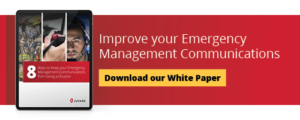 Let’s face it, many of us are so busy we sometimes just let ourselves go. Stuff happens, incidents arise, our focus is elsewhere, and things slip through the cracks. Many people use a new year as a catalyst to get back in shape. In fact, it’s one of the top New Year’s resolutions.
Let’s face it, many of us are so busy we sometimes just let ourselves go. Stuff happens, incidents arise, our focus is elsewhere, and things slip through the cracks. Many people use a new year as a catalyst to get back in shape. In fact, it’s one of the top New Year’s resolutions.
Similarly, our emergency communications ‘muscles’ can get flabby and out of shape when we don’t take the necessary steps to test, analyze, and improve our processes and technology. The new year is a great time to take stock and make some improvements. But where do you start?
At the end of 2019, we asked 344 emergency management pros what aspect of their emergency management capabilities needed the most improvement.
The overwhelming majority said their communication capabilities could be stronger.
We’ll consider that a resolution.
With focus on some of the fundamentals, you can quickly go from being a “97-pound EM communications weakling” to having rock solid emergency communications.
Here are just a couple of the fundamentals. For even more, check out our white paper 8 Tips to Improve Your Emergency Communications.
Work on your Core – Collaboration
There are many parts that make up effective emergency communications, but let’s start with the core.
Without a solid foundation of a centralized emergency management platform, your different communications appendages are working independently of each other. They might be individually strong, but in the long run they have nothing to hold them all together.
The platform you use, then, is the backbone that allows all parts to collaborate and work in concert and to strengthen the entire system.
Organizations communicate more efficiently with centralized operations, where everyone has access to the same critical information at the same time. The right emergency management platform, like WebEOC and Juvare Exchange, connects all the players and stakeholders across arbitrary borders or other hindrances.
This allows the best framework for collaboration as the proper stakeholders have access to the best up-to-date information to get things done.
In other words, you don’t want to just push out information randomly. For a communications process with strength and agility, you want that information to be disseminated in a way that allows and encourages collaboration.
In this type of collaborative process, forms, reports, and information entered into the system can be visualized in maps and dashboards summarizing key information and metrics. Users can update information on important tasks that need to be completed, they can log incidents and events, and coordinate teams while working together in group or one-on-one chats – collaborating on important matters in real time.
An Expert Can Make All the Difference
When you’re trying to get in the best shape, having someone who knows the most efficient approach – who has your back and can spot for you in heavy lift situations – can be key.
Similarly, even the best efforts to keep an emergency management solution working to its full potential can be difficult. Sometimes even organizations who are not new to emergency management technology can fail to make the necessary updates or improvements that maximize their system’s effectiveness.
An experienced partner can help you assess where your system needs the most work.
You can save a ton of extra time and effort by having an expert with knowledge about industry best practices and technology expertise that will make your communications most effective.
If you are like many of the emergency management professionals we have talked to, chances are your communications and collaboration capabilities are not where you would like them to be.
Just like a good fitness regimen, focusing on a few key components can get your processes back in shape and make you more confident about your emergency response, especially when it matters most.
To explore more ways to get your emergency communications in shape, download our white paper 8 Tips to Improve Your Emergency Management Communications.





